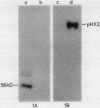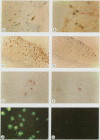Abstract
A monoclonal antibody was raised against the major capsid protein L1 of human papillomavirus type 16, using a recombinant vaccinia virus that expresses the L1 protein, as a target for screening. This antibody, designated CAMVIR-1, reacted with a 56 kilodalton protein in cells infected with L1-vaccinia virus, and the protein was present in a predominantly nuclear location. The antibody also detects the HPV-16 L1 antigen in formalin fixed, paraffin wax embedded biopsy specimens and on routine cervical smears. The antibody reacts strongly and consistently with biopsy specimens containing HPV-16 or HPV-33, but very weak reactions were occasionally observed with biopsy specimens or smears containing HPV-6 or HPV-11. The potential advantages of using a vaccinia recombinant are (i) the target protein is synthesised in a eukoryotic cell so that its "processing" and location are normal; (ii) cells infected with vaccinia recombinants can be subjected to various fixing procedures similar to those used for routine clinical material. This greatly increases the probability that an identified antibody will be useful in a clinical setting.
Full text
PDF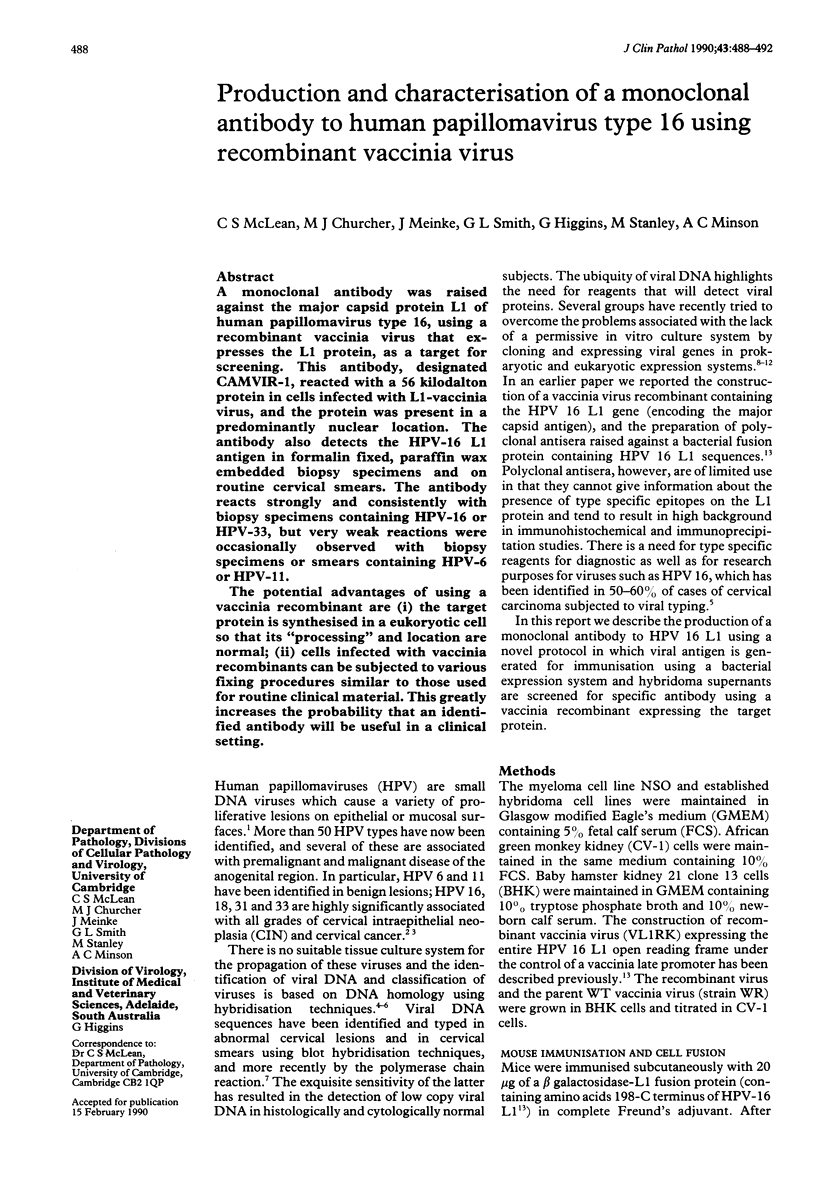
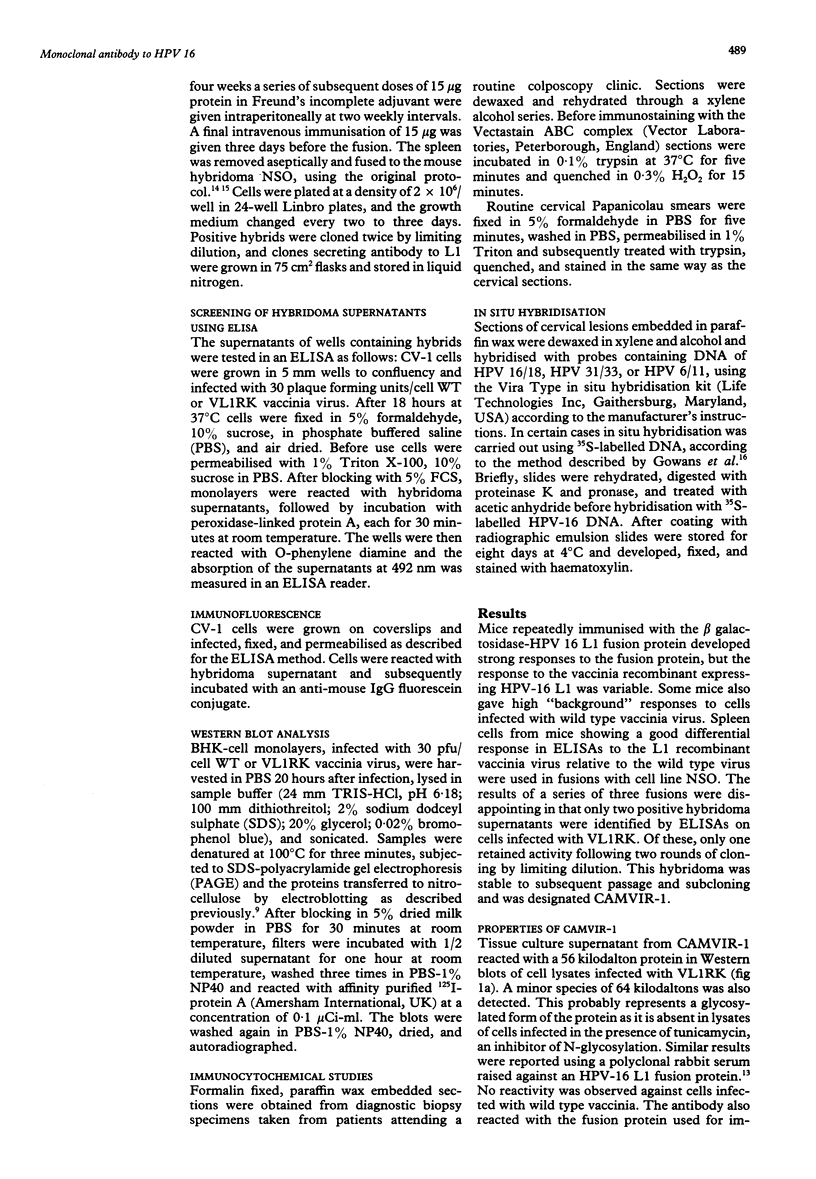
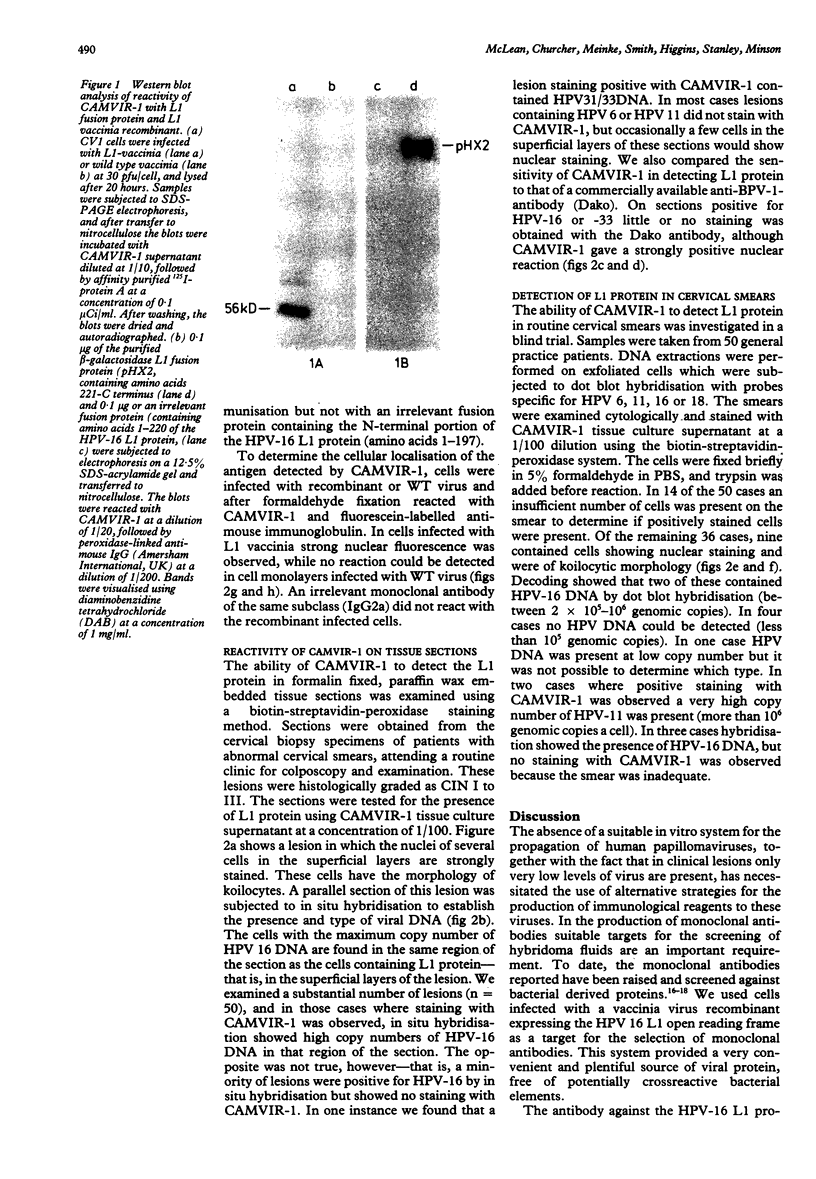
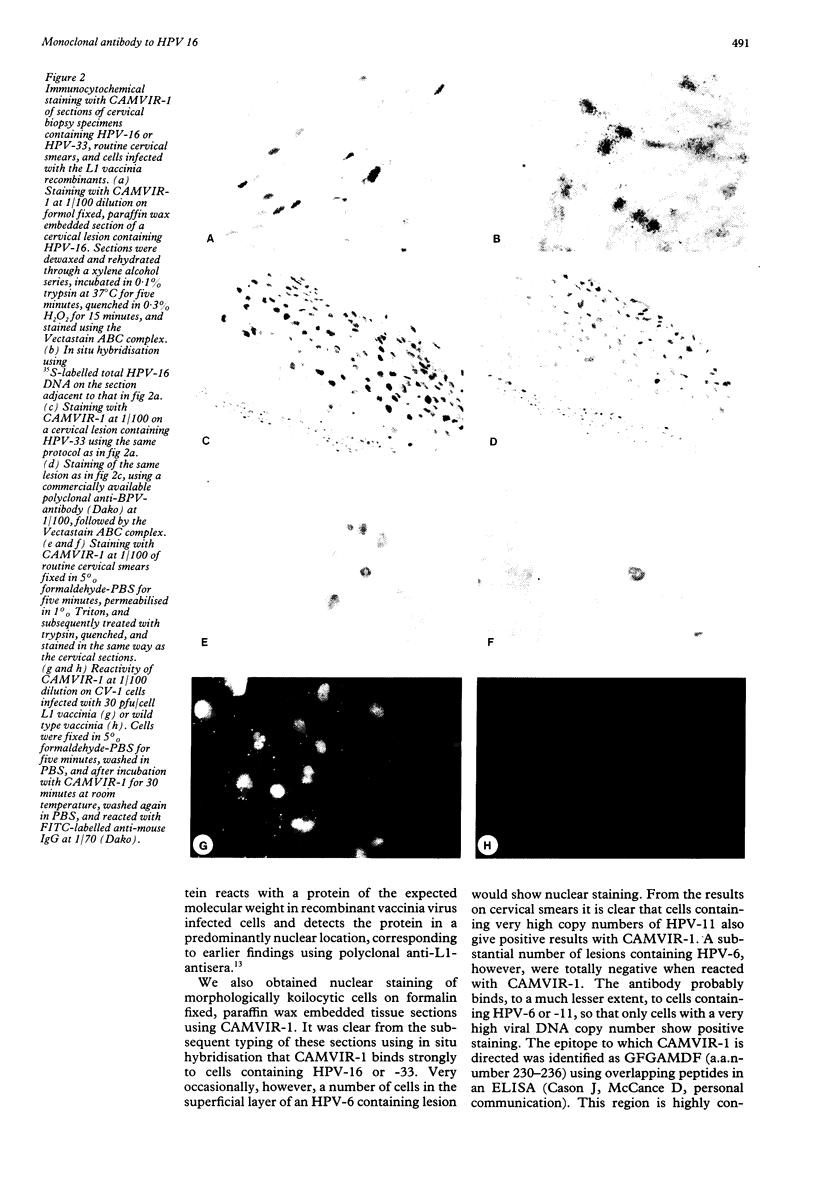
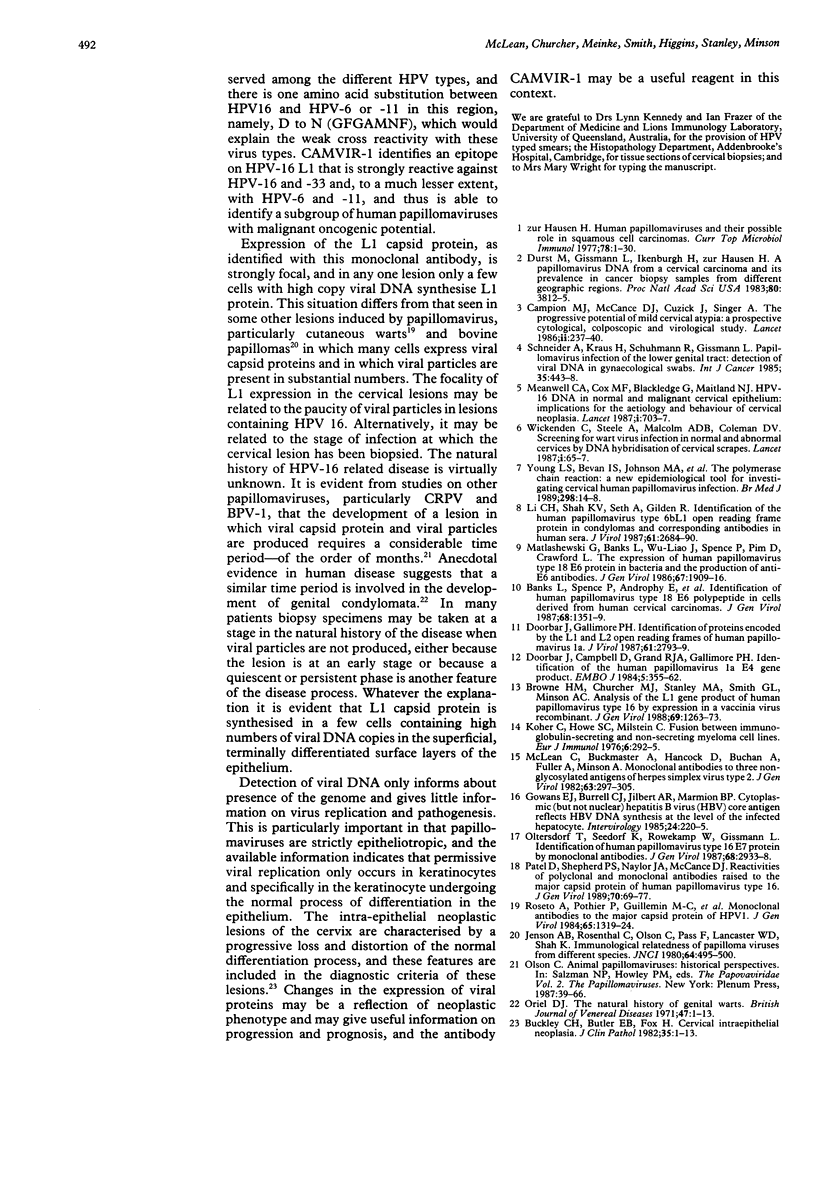
Images in this article
Selected References
These references are in PubMed. This may not be the complete list of references from this article.
- Banks L., Spence P., Androphy E., Hubbert N., Matlashewski G., Murray A., Crawford L. Identification of human papillomavirus type 18 E6 polypeptide in cells derived from human cervical carcinomas. J Gen Virol. 1987 May;68(Pt 5):1351–1359. doi: 10.1099/0022-1317-68-5-1351. [DOI] [PubMed] [Google Scholar]
- Browne H. M., Churcher M. J., Stanley M. A., Smith G. L., Minson A. C. Analysis of the L1 gene product of human papillomavirus type 16 by expression in a vaccinia virus recombinant. J Gen Virol. 1988 Jun;69(Pt 6):1263–1273. doi: 10.1099/0022-1317-69-6-1263. [DOI] [PubMed] [Google Scholar]
- Buckley C. H., Butler E. B., Fox H. Cervical intraepithelial neoplasia. J Clin Pathol. 1982 Jan;35(1):1–13. doi: 10.1136/jcp.35.1.1. [DOI] [PMC free article] [PubMed] [Google Scholar]
- Campion M. J., McCance D. J., Cuzick J., Singer A. Progressive potential of mild cervical atypia: prospective cytological, colposcopic, and virological study. Lancet. 1986 Aug 2;2(8501):237–240. doi: 10.1016/s0140-6736(86)92067-2. [DOI] [PubMed] [Google Scholar]
- Doorbar J., Campbell D., Grand R. J., Gallimore P. H. Identification of the human papilloma virus-1a E4 gene products. EMBO J. 1986 Feb;5(2):355–362. doi: 10.1002/j.1460-2075.1986.tb04219.x. [DOI] [PMC free article] [PubMed] [Google Scholar]
- Doorbar J., Gallimore P. H. Identification of proteins encoded by the L1 and L2 open reading frames of human papillomavirus 1a. J Virol. 1987 Sep;61(9):2793–2799. doi: 10.1128/jvi.61.9.2793-2799.1987. [DOI] [PMC free article] [PubMed] [Google Scholar]
- Dürst M., Gissmann L., Ikenberg H., zur Hausen H. A papillomavirus DNA from a cervical carcinoma and its prevalence in cancer biopsy samples from different geographic regions. Proc Natl Acad Sci U S A. 1983 Jun;80(12):3812–3815. doi: 10.1073/pnas.80.12.3812. [DOI] [PMC free article] [PubMed] [Google Scholar]
- Gowans E. J., Burrell C. J., Jilbert A. R., Marmion B. P. Cytoplasmic (but not nuclear) hepatitis B virus (HBV) core antigen reflects HBV DNA synthesis at the level of the infected hepatocyte. Intervirology. 1985;24(4):220–225. doi: 10.1159/000149646. [DOI] [PubMed] [Google Scholar]
- Jenson A. B., Rosenthal J. D., Olson C., Pass F., Lancaster W. D., Shah K. Immunologic relatedness of papillomaviruses from different species. J Natl Cancer Inst. 1980 Mar;64(3):495–500. [PubMed] [Google Scholar]
- Köhler G., Howe S. C., Milstein C. Fusion between immunoglobulin-secreting and nonsecreting myeloma cell lines. Eur J Immunol. 1976 Apr;6(4):292–295. doi: 10.1002/eji.1830060411. [DOI] [PubMed] [Google Scholar]
- Li C. C., Shah K. V., Seth A., Gilden R. V. Identification of the human papillomavirus type 6b L1 open reading frame protein in condylomas and corresponding antibodies in human sera. J Virol. 1987 Sep;61(9):2684–2690. doi: 10.1128/jvi.61.9.2684-2690.1987. [DOI] [PMC free article] [PubMed] [Google Scholar]
- Matlashewski G., Banks L., Wu-Liao J., Spence P., Pim D., Crawford L. The expression of human papillomavirus type 18 E6 protein in bacteria and the production of anti-E6 antibodies. J Gen Virol. 1986 Sep;67(Pt 9):1909–1916. doi: 10.1099/0022-1317-67-9-1909. [DOI] [PubMed] [Google Scholar]
- McLean C., Buckmaster A., Hancock D., Buchan A., Fuller A., Minson A. Monoclonal antibodies to three non-glycosylated antigens of herpes simplex virus type 2. J Gen Virol. 1982 Dec;63(2):297–305. doi: 10.1099/0022-1317-63-2-297. [DOI] [PubMed] [Google Scholar]
- Meanwell C. A., Cox M. F., Blackledge G., Maitland N. J. HPV 16 DNA in normal and malignant cervical epithelium: implications for the aetiology and behaviour of cervical neoplasia. Lancet. 1987 Mar 28;1(8535):703–707. doi: 10.1016/s0140-6736(87)90353-9. [DOI] [PubMed] [Google Scholar]
- Oltersdorf T., Seedorf K., Röwekamp W., Gissmann L. Identification of human papillomavirus type 16 E7 protein by monoclonal antibodies. J Gen Virol. 1987 Nov;68(Pt 11):2933–2938. doi: 10.1099/0022-1317-68-11-2933. [DOI] [PubMed] [Google Scholar]
- Oriel J. D. Natural history of genital warts. Br J Vener Dis. 1971 Feb;47(1):1–13. doi: 10.1136/sti.47.1.1. [DOI] [PMC free article] [PubMed] [Google Scholar]
- Patel D., Shepherd P. S., Naylor J. A., McCance D. J. Reactivities of polyclonal and monoclonal antibodies raised to the major capsid protein of human papillomavirus type 16. J Gen Virol. 1989 Jan;70(Pt 1):69–77. doi: 10.1099/0022-1317-70-1-69. [DOI] [PubMed] [Google Scholar]
- Roseto A., Pothier P., Guillemin M. C., Peries J., Breitburd F., Bonneaud N., Orth G. Monoclonal antibodies to the major capsid protein of human papillomavirus type 1. J Gen Virol. 1984 Aug;65(Pt 8):1319–1324. doi: 10.1099/0022-1317-65-8-1319. [DOI] [PubMed] [Google Scholar]
- Schneider A., Kraus H., Schuhmann R., Gissmann L. Papillomavirus infection of the lower genital tract: detection of viral DNA in gynecological swabs. Int J Cancer. 1985 Apr 15;35(4):443–448. doi: 10.1002/ijc.2910350405. [DOI] [PubMed] [Google Scholar]
- Young L. S., Bevan I. S., Johnson M. A., Blomfield P. I., Bromidge T., Maitland N. J., Woodman C. B. The polymerase chain reaction: a new epidemiological tool for investigating cervical human papillomavirus infection. BMJ. 1989 Jan 7;298(6665):14–18. doi: 10.1136/bmj.298.6665.14. [DOI] [PMC free article] [PubMed] [Google Scholar]
- zur Hausen H. Human papillomaviruses and their possible role in squamous cell carcinomas. Curr Top Microbiol Immunol. 1977;78:1–30. doi: 10.1007/978-3-642-66800-5_1. [DOI] [PubMed] [Google Scholar]



